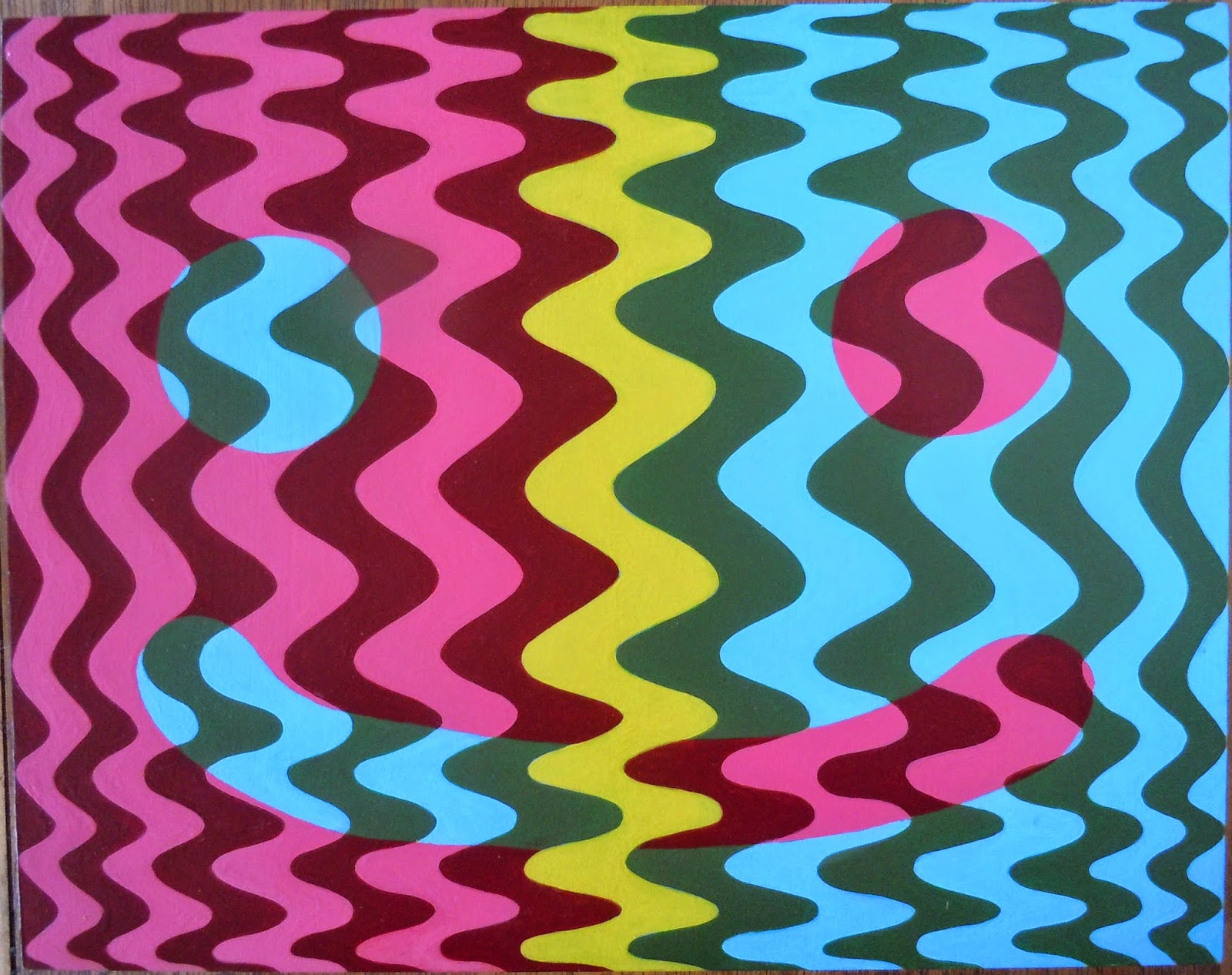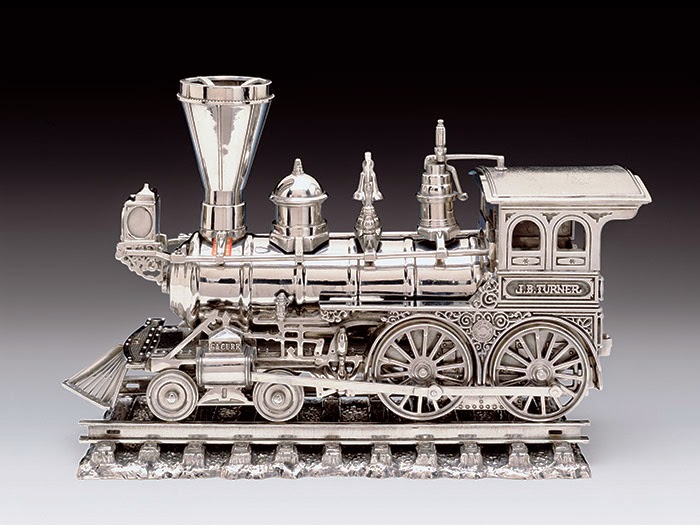by Claire Cushman, MFA 2015
When I met with Ken Johnson, he had just been to see Jeff Koons’ “Jim Beam – J.B. Turner Engine,” and six individual train cars (toy sized, silvery stainless steel, filled with Jim Beam Bourbon), at Craig F Starr gallery. He placed the catalogue on the table. I asked him how he chooses what to write about.
“Why am I writing about Jeff Koons? I actually think Jeff Koons has been a great artist… This work was from ‘86, and I’m very interested in the eighties – it was a really explosive time in the art world. I may be interested in a show for its historical significance, or because it’s an artist who’s making waves now– I write for lots of different reasons.”
Johnson has written for the New York Times for 17 years. (You can read his March 5threview of the Koons show here.) He is also the author of “Are You Experienced? How Psychedelic Consciousness Transformed Modern Art.” Unlike many art critics, he also comes from a studio art background.
In mid-February, Johnson conducted critiques for Academy second-years. I found his critiques insightful, accessible, and entertaining. As an artist and a writer, I was curious to hear about his background, and his thoughts on art and writing, so I tracked him down to ask.
Below is our conversation:
Can you tell me about your studio background?
Well, I majored in studio art at Brown, but I only took three studio courses and a bunch of art history courses. Really I did more English courses. I wanted to become a novelist first, but I found writing fiction almost impossible. I was much better at writing expository, analytic stuff. I didn’t really know what I was going to do when I graduated, so I applied for an MA in painting at SUNY Albany, and then did that.
 |
| Gladys Nilsson of the Chicago Imagists, “Turnabout Walk” |
What kind of work were you interested in in grad school?
In grad school, I discovered the Chicago imagists, these artists associated with the Hairy Who. This art was kinda funky pop – more fantasy, surrealism than New York Pop… And I’ve always been interested in outsider art.
Was grad school a positive experience for you?
Yes. What happens in grad school, if you’re lucky, is you start out doing one thing and you end up doing something that you never imagined, or were capable of doing. Chances are, you start out with some fixed ideas that you’re better off without. But you have to fail trying to do them. You have to be broken down, and then at some point you go “oh, that’s what art is!” – at least that’s how I experienced it.
How did you transition from a Masters in painting to criticism?
After grad school, I got a job working in as an assistant art conservator. In that job, I learned all this woodworking and how to do things with materials. I definitely learned more technical stuff from that job than I did from grad school. I had a basement studio, and at night I was making wood sculpture. I was working all day at a conservation lab sanding glue off the back of an old canvas, and then I’d come home and be sanding this thing I was making too, and at a certain point I felt like I had such a strong desire to READ, and I had to just stop. Also, after a few years of that work, my immune system was injured by all the solvents and chemicals. Then some friends started an art criticism-reading group, and I began writing things in response to pieces we were reading, and I really got into it. And then I started writing reviews for the Albany Times Union. And then one thing just led to another.
Did you keep painting when
 |
| Narcissus, by Ken Johnson |
you started writing?
Once I started writing I pretty much stopped making art. I was married and had two little kids, so I just couldn’t really think about doing anything else. As a freelancer I just didn’t have regular time to do it.
Do you ever wish you’d seriously pursued art instead of writing?
I could’ve been an artist, but I wasn’t one of those people that was singled out as something special. So I feel pretty good about being a critic. Sometimes the grind of weekly deadlines makes me feel like “let me out of this” – but it’s always something different and I’m always learning, and hopefully evolving in my own consciousness of what writing and writing about art is. I really like the process of looking and trying to figure out why I’m having a response to a given object. Why am I thrilled, why am I disappointed?
Do you make your own art now?
In the past ten years or so, my life has been more settled, and I’ve found myself with time in the evenings, so I started painting again. I make these small, acrylic, geometric op-art paintings… they’re about perception, really. (show photos?) I work in my lap though, I don’t have a studio –I sit and paint with a Netflix movie on so I don’t get too bored. And a couple years ago I started producing this series of cartoons based on these two characters – ball and cone –I’ve made hundreds of these pen and ink drawings. They’re sort of philosophical, I’m kind of a philosophy junkie.
How do you define successful a work of art?
The intention of any piece of art is to make the viewer feel something. If everything in the work is working together to make me feel a certain way – that’s when it’s really good art. I don’t think I’ve ever really said it like that before – a unified reaction.
What do you think has led to your success as an art critic?
Two things. First, I can write clearly. If you can write in an accessible, grammatically correct, interesting, and even entertaining way, that goes a long way. Secondly, I don’t have any ideological axe to grind. I’m willing to look at different sorts of things and judge them on a case by case basis, rather than advocating for one way of doing or thinking about things.
How much does one need to know about art history or contemporary art to write about art?
I’ve taught criticism before and I always say anybody can write art criticism. The whole thing of it is, how do you take your felt response to what you’re seeing and put that into words? It’s not about what you know, it’s about what you feel. Over time, you accumulate a lot of knowledge, but I didn’t have any training to do this. I don’t think knowing a lot about art history is a primary prerequisite for a critic starting out. But then of course at some point, you gotta know what you’re talking about.


How do you think your background in studio art has shaped you as a critic? Do you ever feel like you have a better understanding of art than other critics because you’ve actually made things?
I don’t know what it would be like to be a critic and not know how things are made. Having made art, you know it with your body. You’ve made it with your hands, you know what it smells like and feels like, you know what the consistency of paint is… I can identify with or empathize with people who are making stuff. Sometimes I’ll see how something is made and think, “why would anybody make something that way?” Not that it’s bad or wrong, it’s just not the way I would do it. And sometimes I’ll see something I like and one of the things I like about it is that it excites my own creative juices, and I think “oh, I wanna make something like that.”
Do you think you’re more of a visual or verbal person? Do you think much about that split?
This is something I’ve puzzled over since I was in college, because I wanted to do both… When I was a freshman, I went to a friend’s final studio presentation. He had these glass slides, with these transparencies, and projected them as a series of images with music, and I remember it just blew my mind. Afterward, I would lie in bed going to sleep visualizing these slides, thinking, “well what would I do if I could do that?” It was just so visually exciting to me. But making art for me is a much more narrow and focused activity. I think ultimately I have more of a discursive mind, so making art will always be secondary for me. For me the process of interpretation is really exciting. I couldn’t give up being a writer.
How much do you think your criticism has an impact on the art world and art market?
Some critics can really affect the market. I’m not sure that I do or how I fit in. I think the people at the Times like what I do because they think I’m a good writer. And if I review a show more people will go see it. But I don’t think I have much influence in the market. I have no interest in effecting the market, and the things I like and am interested in are often not the market meters – I don’t worry about it. It’s a pretty good gig to be able to just write about whatever I want and be free to say what I think about it.
How do you deal with the backlash you sometimes get for your writing?
Well, it makes a lot of noise but it’s only happened 3 times in 17 years. Well, there have probably been lots of things I’ve written that have angered people, but it’s because of Facebook that they blow up and become widely known. People who haven’t read anything by me will read this one thing and they go “AH! He’s sexist and racist.” Not all people are very good readers, and a lot of people are not very good at ambiguity or subtlety – I’ll get quoted out of context, or they’ll quote half a sentence. You know, the narcissist in me is like “this is great, everybody’s talking about me!” and since I don’t think I was wrong, I don’t really mind. Being an art critic is an ongoing performance in the paper every week.
###

